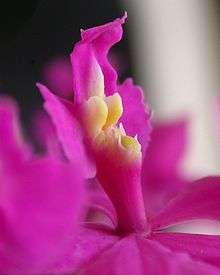Epidendrum subsect. Carinata
Epidendrum subsect. Carinata Rchb.f. (1861) is a subsection of the section E. sect. Schistochila Rchb.f. (1861) of the subgenus E. subg. Amphiglottium Lindl. (1841) of the genus Epidendrum of the Orchidaceae (orchid family). This subsection differs from the subsection E. subsect. Integra in that the margins of the trilobate lip are dentate or lacerate. This subsection differes from the subsection E. subsect. Tuberculata by possessing a keel or carina on the midlobe of the lip. In 1861, Reichenbach listed nine species in this subsection.[1]
- E. attenuatum Lindl. (1853) (p. 389)
- E. calanthum Rchb.f. & Warsz. (1854) as E. calanthum (p. 390) and E. paytense (p. 391)
- E. cinnabarinum Salzmann ex Lindl. (1831) (p. 389)
- E. imatophyllum Lindl. (1831) (p. 391) As of August 1, 2009, the World Checklist had no entry for this binomial, but accepted E. flexuosum G.Mey. (1818),[2] which Reichenbach 1861 lists as a possible synonym. Kew listed E. imantophyllum with the same reference to Lindley, 1831. Lindley 1831 spells it E. imatophyllum.[3]
- E. fulgens Brogn. (1834) as a synonym of E. schomburgkii var. conflens (p. 389-390)
- E. ibaguense Kunth (1816) as E. decipiens Lindl. (1853) (p. 391) and E. schomburgkii var. conflens (p. 389-390)
- E. macrocarpum A.Rich. (1792) as E. schomburgkii Lindl. (1838) (pp. 389–390)
- E. radicans Pav. ex Lindl.(1831) (p. 390)
- E. spicatum Hook.f. (1851) (p. 389)
| Epidendrum subsect. Carinata | |
|---|---|
 | |
| E. denticulatum lip, showing keel, or carina | |
| Scientific classification | |
| Kingdom: | Plantae |
| Clade: | Tracheophytes |
| Clade: | Angiosperms |
| Clade: | Monocots |
| Order: | Asparagales |
| Family: | Orchidaceae |
| Subfamily: | Epidendroideae |
| Genus: | Epidendrum |
| Subgenus: | Epidendrum subg. Amphiglottium |
| Section: | Epidendrum sect. Schistochila |
| Subsection: | Epidendrum subsect. Carinata Rchb.f. |
E. puniceoluteum was placed in E. subsect. Carinata in its publication as a new species in 2007.[4]
E. denticulatum was also acknowledged to be in E. subsect. Carinata in Pinheiro and Barros 2007.
Cytology
The observed diploid chromosome numbers within Epidendrum subsect. Carinata are rather variable:[5]
- 24 for E. flexuoxum and an individual of E. fulgens described as E. mosenii
- 28 for E. fulgens
- 30 for E. calanthum
- 40 for E. denticulatum and E. radicans
- 52 for E. puniceoluteum
- 60 for E. radicans
- 70 for E. ibaguense and E. radicans
- ~240 for E. cinnabarinum
References
- Reichenbach, H. G. "ORCHIDES" in Müller, Carl, Ed. Walpers Annales Botanices Systematicae 6(1861)373-397. Berlin. 1861.
- apps.kew.org/wcsp/
- Lindley, J. The Genera and Species of Orchidaceous Plants pp. 106-107, Ridgways. London. April 1830 to October 1840. Found at https://www.biodiversitylibrary.org/item/9889
- Pinheiro, F., and Barros, F.: "Epidendrum puniceoluteum, uma nova especie de Orchidaceae do litoral brasileiro" Hoehnea 33(2):247-250, 2007
- page 251 of Leonardo P. Felix and Marcelo Guerra: "Variation in chromosome number and the basic number of subfamily Epidendroideae (Orchidaceae)" Botanical Journal of the Linnean Society 163(2010)234-278. The Linnean Society of London. downloaded October 2010 from http://onlinelibrary.wiley.com/doi/10.1111/j.1095-8339.2010.01059.x/pdf